一、在你使用GLTFLoader加载gltf文件时,你会发现你只需要调用GLTFloader的load方法就可以在,回调函数中拿到Scene对象。所以当你调用GLTFLoader.load时就完成了整个加载解析过程。所以,我们从GLTFLoader.load开始了解整个GLTF文件的加载解析流程。
load源码如下:
1
2
3
4
5
6
7
8
9
10
11
12
13
14
15
16
17
18
19
20
21
22
23
24
25
26
27
28
29
30
31
32
33
34
35
36
37
38
39
40
41
42
43
44
45
46
47
48
49
50
51
52
53
54
55
56
57
58
59
60
61
62
63
64
65
66
67
68
69
70 load( url, onLoad, onProgress, onError ) {
const scope = this;
let resourcePath;
if ( this.resourcePath !== '' ) {
resourcePath = this.resourcePath;
} else if ( this.path !== '' ) {
resourcePath = this.path;
} else {
resourcePath = LoaderUtils.extractUrlBase( url );
}
// Tells the LoadingManager to track an extra item, which resolves after
// the model is fully loaded. This means the count of items loaded will
// be incorrect, but ensures manager.onLoad() does not fire early.
this.manager.itemStart( url );
const _onError = function ( e ) {
if ( onError ) {
onError( e );
} else {
console.error( e );
}
scope.manager.itemError( url );
scope.manager.itemEnd( url );
};
const loader = new FileLoader( this.manager );
loader.setPath( this.path );
loader.setResponseType( 'arraybuffer' );
loader.setRequestHeader( this.requestHeader );
loader.setWithCredentials( this.withCredentials );
loader.load( url, function ( data ) {
try {
scope.parse( data, resourcePath, function ( gltf ) {
onLoad( gltf );
scope.manager.itemEnd( url );
}, _onError );
} catch ( e ) {
_onError( e );
}
}, onProgress, _onError );
}关注这段源码的第54行,前面的代码完成了文件的网络请求获取到二进制数据放在data变量中,然后调用scope.parse就是完成二进制数据转为Scene对象的方法。关注这段源码第3行scope其实就是GLTFLoader实例自身,所以这里调用的scope.parse就是GLTFLoader类中实现的parse方法,源码如下:
1
2
3
4
5
6
7
8
9
10
11
12
13
14
15
16
17
18
19
20
21
22
23
24
25
26
27
28
29
30
31
32
33
34
35
36
37
38
39
40
41
42
43
44
45
46
47
48
49
50
51
52
53
54
55
56
57
58
59
60
61
62
63
64
65
66
67
68
69
70
71
72
73
74
75
76
77
78
79
80
81
82
83
84
85
86
87
88
89
90
91
92
93
94
95
96
97
98
99
100
101
102
103
104
105
106
107
108
109
110
111
112
113
114
115
116
117
118
119 parse( data, path, onLoad, onError ) {
let json;
const extensions = {};
const plugins = {};
const textDecoder = new TextDecoder();
if ( typeof data === 'string' ) {
json = JSON.parse( data );
} else if ( data instanceof ArrayBuffer ) {
const magic = textDecoder.decode( new Uint8Array( data, 0, 4 ) );
if ( magic === BINARY_EXTENSION_HEADER_MAGIC ) {
try {
extensions[ EXTENSIONS.KHR_BINARY_GLTF ] = new GLTFBinaryExtension( data );
} catch ( error ) {
if ( onError ) onError( error );
return;
}
json = JSON.parse( extensions[ EXTENSIONS.KHR_BINARY_GLTF ].content );
} else {
json = JSON.parse( textDecoder.decode( data ) );
}
} else {
json = data;
}
if ( json.asset === undefined || json.asset.version[ 0 ] < 2 ) {
if ( onError ) onError( new Error( 'THREE.GLTFLoader: Unsupported asset. glTF versions >=2.0 are supported.' ) );
return;
}
const parser = new GLTFParser( json, {
path: path || this.resourcePath || '',
crossOrigin: this.crossOrigin,
requestHeader: this.requestHeader,
manager: this.manager,
ktx2Loader: this.ktx2Loader,
meshoptDecoder: this.meshoptDecoder
} );
parser.fileLoader.setRequestHeader( this.requestHeader );
for ( let i = 0; i < this.pluginCallbacks.length; i ++ ) {
const plugin = this.pluginCallbacks[ i ]( parser );
plugins[ plugin.name ] = plugin;
// Workaround to avoid determining as unknown extension
// in addUnknownExtensionsToUserData().
// Remove this workaround if we move all the existing
// extension handlers to plugin system
extensions[ plugin.name ] = true;
}
if ( json.extensionsUsed ) {
for ( let i = 0; i < json.extensionsUsed.length; ++ i ) {
const extensionName = json.extensionsUsed[ i ];
const extensionsRequired = json.extensionsRequired || [];
switch ( extensionName ) {
case EXTENSIONS.KHR_MATERIALS_UNLIT:
extensions[ extensionName ] = new GLTFMaterialsUnlitExtension();
break;
case EXTENSIONS.KHR_DRACO_MESH_COMPRESSION:
extensions[ extensionName ] = new GLTFDracoMeshCompressionExtension( json, this.dracoLoader );
break;
case EXTENSIONS.KHR_TEXTURE_TRANSFORM:
extensions[ extensionName ] = new GLTFTextureTransformExtension();
break;
case EXTENSIONS.KHR_MESH_QUANTIZATION:
extensions[ extensionName ] = new GLTFMeshQuantizationExtension();
break;
default:
if ( extensionsRequired.indexOf( extensionName ) >= 0 && plugins[ extensionName ] === undefined ) {
console.warn( 'THREE.GLTFLoader: Unknown extension "' + extensionName + '".' );
}
}
}
}
parser.setExtensions( extensions );
parser.setPlugins( plugins );
parser.parse( onLoad, onError );
}这段代码的执行截止到第48行,完成了二进制流到json串的转化。下面是我使用了一个gltf模型文件进行调试时在第48行后面进行打印出的一个数据结果:
 如果你尝试用文本编辑器打开gltf文件,你会发现它其实就是一个json文本,下面是我在vscode中打开了一个gltf文件:
如果你尝试用文本编辑器打开gltf文件,你会发现它其实就是一个json文本,下面是我在vscode中打开了一个gltf文件:
 关于gltf更详细的文件定义可以参看https://github.com/KhronosGroup/glTF
这里只将重要的文件定义内容展示:
关于gltf更详细的文件定义可以参看https://github.com/KhronosGroup/glTF
这里只将重要的文件定义内容展示:
 图片中为你描述了json结构中各个属性的含义,在后面会详细解释如何理解每个字段。
接下来让我们继续将视线回到threejs源码。拿到gltf中的json数据之后,50-60行将其传给GLTFParser的构造函数,60-116为解析过程准备需要的插件和扩展工具。最后一行调用GLTFParser.parse进行解析,源码如下:
图片中为你描述了json结构中各个属性的含义,在后面会详细解释如何理解每个字段。
接下来让我们继续将视线回到threejs源码。拿到gltf中的json数据之后,50-60行将其传给GLTFParser的构造函数,60-116为解析过程准备需要的插件和扩展工具。最后一行调用GLTFParser.parse进行解析,源码如下:
1
2
3
4
5
6
7
8
9
10
11
12
13
14
15
16
17
18
19
20
21
22
23
24
25
26
27
28
29
30
31
32
33
34
35
36
37
38
39
40
41
42
43
44
45
46
47
48
49
50
51
52
53
54
55
56
57
58
59
60 parse( onLoad, onError ) {
const parser = this;
const json = this.json;
const extensions = this.extensions;
// Clear the loader cache
this.cache.removeAll();
this.nodeCache = {};
// Mark the special nodes/meshes in json for efficient parse
this._invokeAll( function ( ext ) {
return ext._markDefs && ext._markDefs();
} );
Promise.all( this._invokeAll( function ( ext ) {
return ext.beforeRoot && ext.beforeRoot();
} ) ).then( function () {
return Promise.all( [
parser.getDependencies( 'scene' ),
parser.getDependencies( 'animation' ),
parser.getDependencies( 'camera' ),
] );
} ).then( function ( dependencies ) {
const result = {
scene: dependencies[ 0 ][ json.scene || 0 ],
scenes: dependencies[ 0 ],
animations: dependencies[ 1 ],
cameras: dependencies[ 2 ],
asset: json.asset,
parser: parser,
userData: {}
};
addUnknownExtensionsToUserData( extensions, result, json );
assignExtrasToUserData( result, json );
Promise.all( parser._invokeAll( function ( ext ) {
return ext.afterRoot && ext.afterRoot( result );
} ) ).then( function () {
onLoad( result );
} );
} ).catch( onError );
}注意与前面GLTFLoader类中实现的parse方法区分,这里是GLTFParser中的parse。GLTFLoader.parse准备好json数据和需要的插件和扩展后,调用GLTFParser.parse来做最终的解析。 你可以看到这段代码的第54行,就是你在调用时传入的onLoad回调函数,层层传参至此,做最终的回调。而这里的result就是你想拿到的最终数据。 因为前面在GLTFLoader.parse中拿到gltf中的json数据之后,在那段源码的50~60行将其传给GLTFParser的构造函数,所以GLTFParser.parse这段源码第4行的const json = this.json。就是gltf中的json数据,通过传给GLTFParser的构造函数然后通过this获取到这里。
二、那么从这段源码第4行的json到第54行的result中间都经历了什么,让它从一个json最终转变成了你最终想要的场景对象了呢?
其实这个解析过程,就是你去理解这个gltf文件json格式的过程,我先为你讲解,我们应当如何理解gltf的json的一些关键字段。
1.首先是scene:是一个场景索引值,合理取值范围为scenes属性的数组长度,可以没有,默认值为0。
2.scenes字段:
一个对象数组,每一个数组项代表一个scene场景,我们会根据scene的索引值取对应的数组元素。比如这个例子:
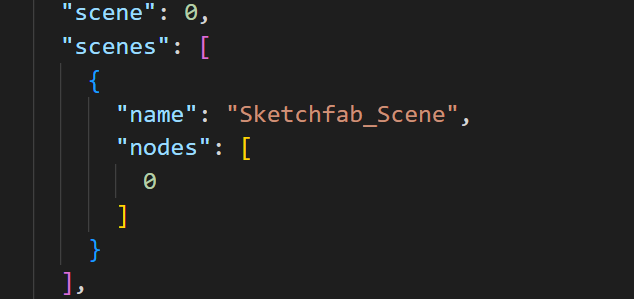 那scene索引就指向了这个name为Sketchfab_Scene,nodes索引为0的这个场景。
3.nodes字段:
nodes字段同样是一个数组,里面放置的就是在上面的举例中,所要解析的scene中nodes索引为0,我们要取得就是该数组得第0个元素。
那scene索引就指向了这个name为Sketchfab_Scene,nodes索引为0的这个场景。
3.nodes字段:
nodes字段同样是一个数组,里面放置的就是在上面的举例中,所要解析的scene中nodes索引为0,我们要取得就是该数组得第0个元素。
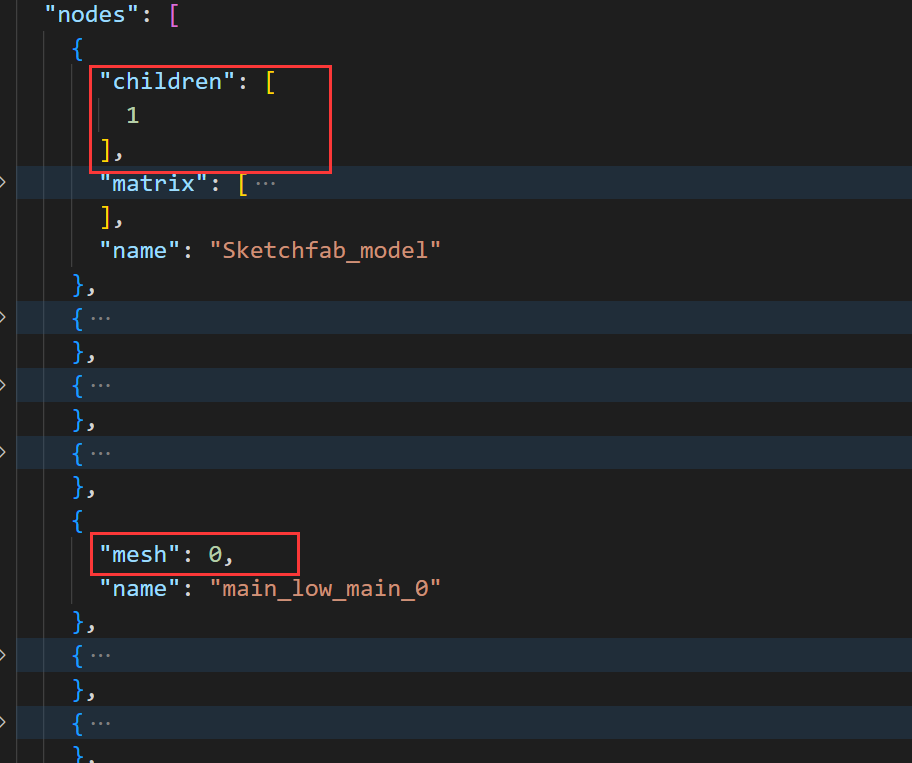 如你所见,这个字段就是一个对象数组,但是数组中可能包含得对象包括children, mesh, camera,skin等等不同的对象。mesh, camera,skin就是最终要渲染得内容,当然一般一个场景必然包含mesh,但未必有camera,skin。如果解析到的是这些对象,直接转去这些json字段中去取即可。但是children对象则需要根据children属性中的索引值,继续在nodes属性中去深度递归,查找替换。如这个例子,我们取得是第一个nodes节点,那么他是一个children,那就意味着这个节点有一个子节点,该子节点是nodes属性数组索引为1得节点(注意这里得1是编程中的索引1,也即数组得第二个元素)。然后按照树得深度递归去查找直到,子节点均为直接渲染属性如mesh。
4.meshs字段:
按照第3步中的递归解析,最终解析到直接渲染元素如mesh,可以参照3中图示的那条mesh数据,它索引值为0,也即这个要渲染的mesh指向了meshs字段的第一个元素:
如你所见,这个字段就是一个对象数组,但是数组中可能包含得对象包括children, mesh, camera,skin等等不同的对象。mesh, camera,skin就是最终要渲染得内容,当然一般一个场景必然包含mesh,但未必有camera,skin。如果解析到的是这些对象,直接转去这些json字段中去取即可。但是children对象则需要根据children属性中的索引值,继续在nodes属性中去深度递归,查找替换。如这个例子,我们取得是第一个nodes节点,那么他是一个children,那就意味着这个节点有一个子节点,该子节点是nodes属性数组索引为1得节点(注意这里得1是编程中的索引1,也即数组得第二个元素)。然后按照树得深度递归去查找直到,子节点均为直接渲染属性如mesh。
4.meshs字段:
按照第3步中的递归解析,最终解析到直接渲染元素如mesh,可以参照3中图示的那条mesh数据,它索引值为0,也即这个要渲染的mesh指向了meshs字段的第一个元素:
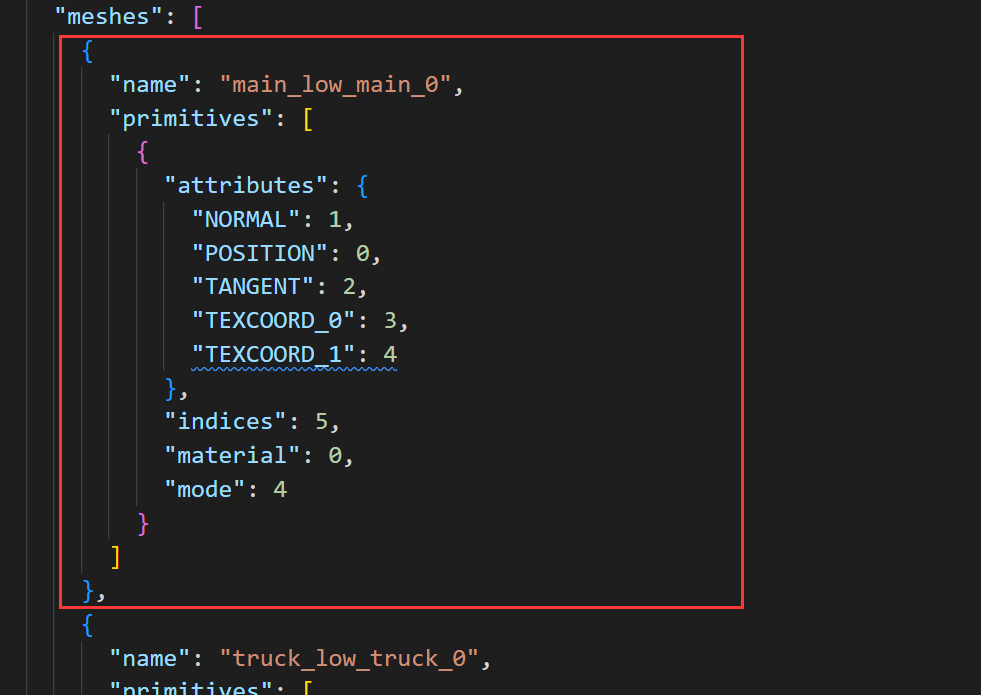 我们都知道,mesh主要应当包含的就是顶点数据,和材质。这个元素,attributes就描述了顶点数据,material就描述了材质信息。依旧按上述索引逻辑在相应的字段去找。这里可能要说明一下的就是,attributes属性的POSITION属性就是这个mesh顶点信息的索引值,该值对应accessors字段。
5.accessors字段:
在上例中POSITION属性值为0,则指向accessors字段的0号索引数据。
我们都知道,mesh主要应当包含的就是顶点数据,和材质。这个元素,attributes就描述了顶点数据,material就描述了材质信息。依旧按上述索引逻辑在相应的字段去找。这里可能要说明一下的就是,attributes属性的POSITION属性就是这个mesh顶点信息的索引值,该值对应accessors字段。
5.accessors字段:
在上例中POSITION属性值为0,则指向accessors字段的0号索引数据。
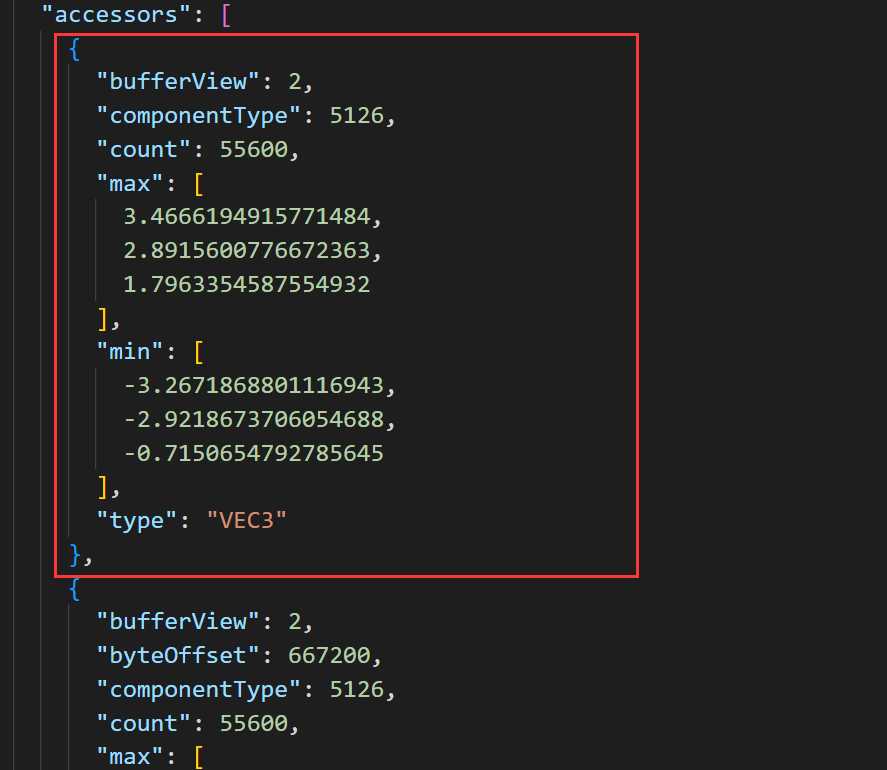
| bufferView | json中bufferView字段的索引 |
|---|---|
| componentType | 数据的类型,如:5120表示byte类型;5121表示ubyte类型;5122表示short类型;5123表示ushort类型;5124表示int类型;5125表示uint类型;5126表示float类型;5130表示double类型。 |
| count | 数据的个数 |
| type | 表示每个元素的数据类型。它可以是以下值之一: |
- "SCALAR":表示每个元素是标量(一个值)。
- "VEC2":表示每个元素是二维矢量。
- "VEC3":表示每个元素是三维矢量。
- "VEC4":表示每个元素是四维矢量。
- "MAT2":表示每个元素是2x2矩阵。
- "MAT3":表示每个元素是3x3矩阵。
- "MAT4":表示每个元素是4x4矩阵。 | | max | 指定每个分量的最大值。它是一个数字数组,其长度取决于type属性 | | min | 指定每个分量的最小值。它是一个数字数组,其长度取决于type属性 |
6.bufferview字段:
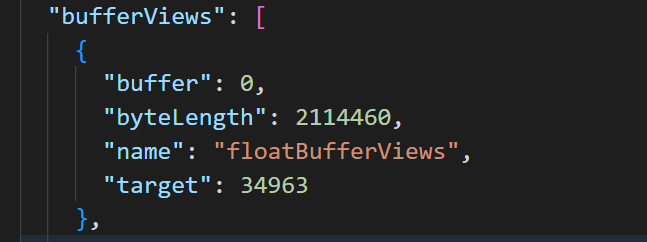 buffer属性为json的buffer字段的索引
7.buffer字段:
buffer属性为json的buffer字段的索引
7.buffer字段:
 uri就指向了最终顶点数据,以二进制形式存放在了scene.bin文件中。当然,也可以直接在里存放所有的二进制数据。
uri就指向了最终顶点数据,以二进制形式存放在了scene.bin文件中。当然,也可以直接在里存放所有的二进制数据。
三、threejs源码又是如何执行这个流程的呢?
再把视线挪回GLTFParser.parse的源码,注意这几行源码:
 从函数名和传参你大概可以猜出,parser.getDependencies( 'scene' )就是递归解析场景数据的方法。沿着
GLTFParse.getDependencies->GLTFParse.getDependency的调用链你可以看到GLTFParse.getDependency源码实现如下:
从函数名和传参你大概可以猜出,parser.getDependencies( 'scene' )就是递归解析场景数据的方法。沿着
GLTFParse.getDependencies->GLTFParse.getDependency的调用链你可以看到GLTFParse.getDependency源码实现如下:
1
2
3
4
5
6
7
8
9
10
11
12
13
14
15
16
17
18
19
20
21
22
23
24
25
26
27
28
29
30
31
32
33
34
35
36
37
38
39
40
41
42
43
44
45
46
47
48
49
50
51
52
53
54
55
56
57
58
59
60
61
62
63
64
65
66
67
68
69
70
71
72
73
74
75
76
77
78
79
80
81
82
83
84
85
86
87
88
89
90
91
92
93
94
95
96
97
98
99
100
101 getDependency( type, index ) {
const cacheKey = type + ':' + index;
let dependency = this.cache.get( cacheKey );
if ( ! dependency ) {
switch ( type ) {
case 'scene':
dependency = this.loadScene( index );
break;
case 'node':
dependency = this._invokeOne( function ( ext ) {
return ext.loadNode && ext.loadNode( index );
} );
break;
case 'mesh':
dependency = this._invokeOne( function ( ext ) {
return ext.loadMesh && ext.loadMesh( index );
} );
break;
case 'accessor':
dependency = this.loadAccessor( index );
break;
case 'bufferView':
dependency = this._invokeOne( function ( ext ) {
return ext.loadBufferView && ext.loadBufferView( index );
} );
break;
case 'buffer':
dependency = this.loadBuffer( index );
break;
case 'material':
dependency = this._invokeOne( function ( ext ) {
return ext.loadMaterial && ext.loadMaterial( index );
} );
break;
case 'texture':
dependency = this._invokeOne( function ( ext ) {
return ext.loadTexture && ext.loadTexture( index );
} );
break;
case 'skin':
dependency = this.loadSkin( index );
break;
case 'animation':
dependency = this._invokeOne( function ( ext ) {
return ext.loadAnimation && ext.loadAnimation( index );
} );
break;
case 'camera':
dependency = this.loadCamera( index );
break;
default:
dependency = this._invokeOne( function ( ext ) {
return ext != this && ext.getDependency && ext.getDependency( type, index );
} );
if ( ! dependency ) {
throw new Error( 'Unknown type: ' + type );
}
break;
}
this.cache.add( cacheKey, dependency );
}
return dependency;
}现在,有了前面对gltf文件的json格式讲解,switch分支内的每个case分支是什么含义你应该十分清楚了吧。最开始传参是scene,也就是解析场景,然后就产生了以下调用链: GLTFParse.getDependency('scene')->GLTFParse.loadScene()->GLTFParse.getDependency('node') ->GLTFParse.loadNode()->...(node递归)...->GLTFParse.getDependency('mesh') ->GLTFParse.loadGeometries->addPrimitiveAttributes->GLTFParser.getDependency( 'accessor') ->GLTFParser.loadAccessor()->GLTFParser.getDependency( 'bufferView')->GLTFParser.loadBufferView() ->GLTFParser.getDependency( 'buffer')->GLTFParser.loadBuffer() 这样层层调用最终读取到二进制顶点数据。并将其组装在mesh对象中,然后所有mesh对象按照gltf的层级结构组成整个场景对象。mesh对象中的geometry属性有很多的buffertrribute,代表了这些数据缓冲区,如position为顶点缓冲区,uv为纹理映射坐标缓冲区,color为片段着色器颜色缓冲区等等。而loadMatarial则将uv缓冲区放进了geometry中,以及在material中存放了纹理资源。